Niche partitioning of Borrelia burgdorferi and Borrelia miyamotoi in the same tick vector and mammalian reservoir species
- PMID: 19996447
- PMCID: PMC2841027
- DOI: 10.4269/ajtmh.2009.09-0208
Niche partitioning of Borrelia burgdorferi and Borrelia miyamotoi in the same tick vector and mammalian reservoir species
Abstract
The Lyme borreliosis agent Borrelia burgdorferi and the relapsing fever group species Borrelia miyamotoi co-occur in the United States. We used species-specific, quantitative polymerase chain reaction to study both species in the blood and skin of Peromyscus leucopus mice and host-seeking Ixodes scapularis nymphs at a Connecticut site. Bacteremias with B. burgdorferi or B. miyamotoi were most prevalent during periods of greatest activity for nymphs or larvae, respectively. Whereas B. burgdorferi was 30-fold more frequent than B. miyamotoi in skin biopsies and mice had higher densities of B. burgdorferi densities in the skin than in the blood, B. miyamotoi densities were higher in blood than skin. In a survey of host-seeking nymphs in 11 northern states, infection prevalences for B. burgdorferi and B. miyamotoi averaged approximately 0.20 and approximately 0.02, respectively. Co-infections of P. leucopus or I. scapularis with both B. burgdorferi and B. miyamotoi were neither more nor less common than random expectations.
Figures
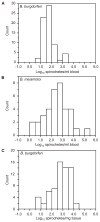
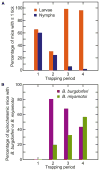
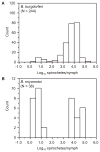
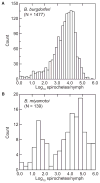
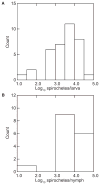
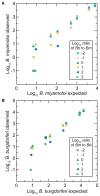
References
-
- Barbour AG. Borrelia: a diverse and ubiquitous genus of tick-borne pathogens. In: Scheld WM, Craig WA, Hughes JM, editors. Emerging Infections. Vol. 5. Washington, DC: American Society for Microbiology Press; 2001. pp. 153–174.
-
- Barbour AG. Relapsing fever. In: Goodman JL, Dennis D, Sonenshine DE, editors. Tick-Borne Diseases of Humans. Washington, DC: ASM Press; 2005. pp. 268–291.
-
- Steere AC, Coburn J, Glickstein L. Lyme borreliosis. In: Goodman JL, Dennis D, Sonenshine DE, editors. Tick-Borne Diseases of Humans. Washington, DC: ASM Press; 2005. pp. 176–206.
-
- Barbour AG, Maupin GO, Teltow GJ, Carter CJ, Piesman J. Identification of an uncultivable Borrelia species in the hard tick Amblyomma americanum: possible agent of a Lyme disease-like illness. J Infect Dis. 1996;173:403–409. - PubMed
Publication types
MeSH terms
Grants and funding
LinkOut - more resources
Full Text Sources
Other Literature Sources
Molecular Biology Databases

